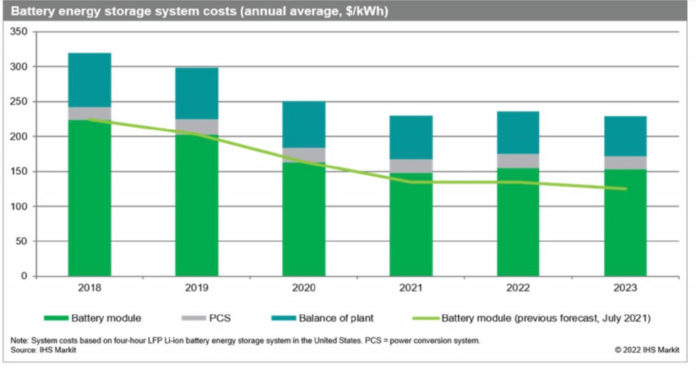A surge in raw material prices could cause EV battery prices to rise, according to a recent Reuters report.
Battery prices have declined consistently over the past few years, but rising prices of nickel, lithium, and other materials—exacerbated by Russia\’s invasion of Ukraine—could halt or even reverse that trend, according to the report.
Nickel prices hit record highs Monday owing to fears that exports from leading producer Russia could be disrupted, the report said, noting that Russian mining company Nornickel producers around 20% of the world\’s high-purity class one nickel, which is used in EV batteries.

Average annual battery energy storage system costs (credit: IHS Markit)
Lithium prices have also risen, more than doubling since the end of 2021, the report said. However, the price of lithium and other raw materials was already rising toward the end of 2021, according to research firm IHS Markit.
In a recent white paper, IHS Markit predicted that surging raw material prices would put further EV battery price declines on hold until 2024. That analysis predicted that average 2022 EV battery prices will be 5% higher than in 2021, mostly due to increased auto-industry demand for lithium iron phosphate (LFP) batteries.
Increased oil prices—another byproduct of the Ukraine conflict—could counterbalance rising EV battery costs, the Reuters report noted. But many of the EVs currently on sale in the United States are expensive luxury models at a time when affordability is key to increasing market share, the report said.

Sono Sion LFP battery pack
While Russia\’s invasion of Ukraine may accelerate raw material price hikes, battery prices increases were already anticipated.
A December 2021 Bloomberg New Energy Finance (BNEF) report predicted that prices might rise in 2022—and, potentially 2023. That could push the $60/kwh (on a pack level) that some see as a goal for affordability farther off.
There were already indicators of how the rapid decrease of cell costs seen a half-decade or more ago was slowing. Some also predict that even as cell costs eventually fall, EVs themselves will cost more to make.









